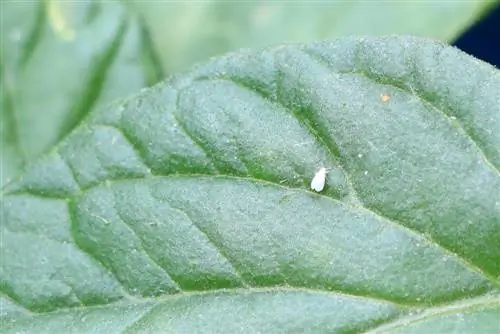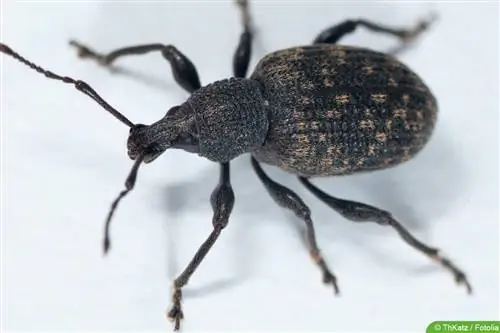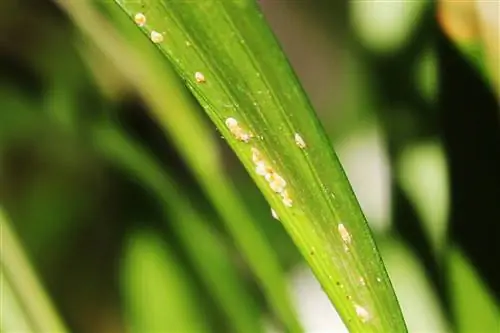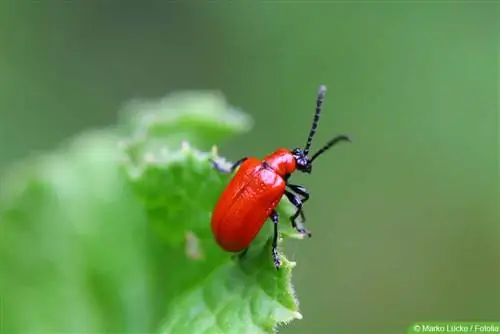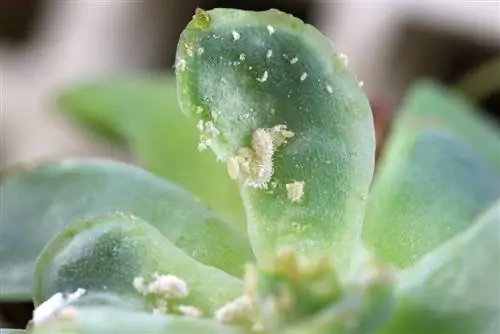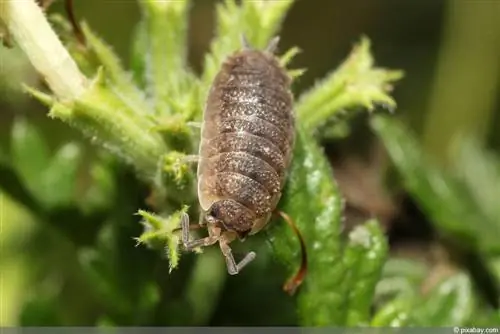- Author admin [email protected].
- Public 2023-12-17 03:39.
- Last modified 2025-01-24 12:45.
If countless white flies flutter away after touching a leaf, the situation is clear: whitefly has conquered the plant, and probably many others in the bed too. Together with their larvae, they cause enormous damage and also promote threatening diseases. Their work should not be tolerated for a day. For the benefit of nature and people, home remedies are the first choice to combat them.
General information about combating
You should first identify this pest - which is actually not a fly, but a winged louse - without any doubt. That shouldn't be difficult. If you touch an infected plant, countless 1-2 mm flies will quickly move away. You may notice white dots or a wax coating on the undersides of the leaves. The leaves can also develop yellow spots, dry out and fall off. There are different species of whitefly. The cabbage scale insect, for example, specializes in brassicas such as cabbage, kohlrabi and kale. Other species prefer other vegetables or even fruit trees. The species is irrelevant for the control. However, combine several agents to catch both hatched lice and larvae.
Tip:
If the infestation has progressed, it may be that the affected plants have now become infected with sooty mold or other diseases. Also examine them for telltale signs.
pruning
Cut back severely affected parts of the plant. For cabbage, you could remove the outer leaves. This is also possible for kohlrabi and kale as well as other types of cabbage, as long as the plant still has enough he althy leaves remaining. Dip the cut plant material in soapy water to kill the larvae. Then put it in a bag, close it tightly and dispose of it with the residual waste.
Water showers
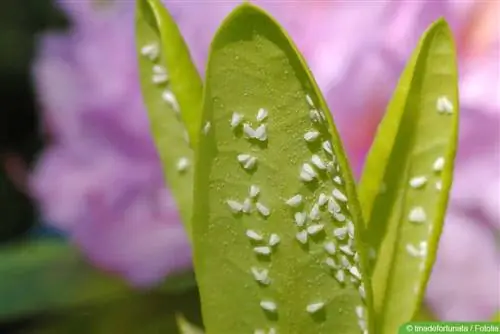
Whitefly larvae cannot hold on well to the leaves and can therefore be easily washed away with a jet of water. Rinse infected plants from below because the larvae are on the undersides of the leaves. This home remedy is suitable for weak infestations or as a supplement to other control methods.
“Climate Change”
The whiteflies like it warm and calm. A preference that they brought with them from their native South America. If a mobile potted plant is affected, it may well be possible to temporarily place it in a cold or at least windy location. There the number of larvae and lice will noticeably decrease.
Note:
Kale becomes fly-free with the first frost at the latest. While this gives the cabbage its full flavor potential, the pests will not survive it. The only question is whether the frost will appear soon after the infestation breaks out.
Yellow boards
The yellow plates are already known to hobby gardeners from combating other pests. They also do a good job with whiteflies as soon as they are placed near affected plants. The winged lice stick to the sticky surfaces of the boards and die. Speed up the destruction process by shaking the plant several times at short intervals. The little lice quickly leave the vegetables, and some of them are guaranteed to hit the table.
Rapeseed oil emulsion
You can fight both larvae and adults with simple, commercially available rapeseed oil. While the rapeseed oil is harmless to the plants, it will form a film around the insects and suffocate them. But first you have to make a spray out of it.
- Mix rapeseed oil with water
- For every 300 ml of oil add 700 ml of water
- shake well
- feel in the squeeze bottle
- spray entire plant
- Don’t forget the undersides of the leaves
- repeat every 4-5 days
Note:
Do not spray the plants while the blazing sun is shining on them. This can lead to burns.
Stinging nettle manure
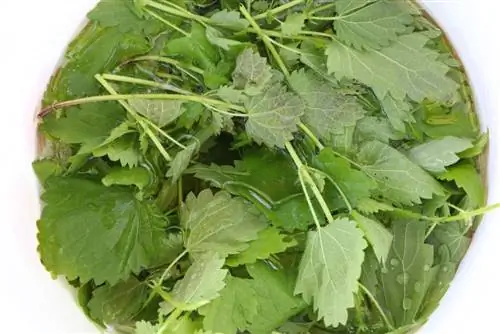
Nettle manure is known to many hobby gardeners as a free and ecologically harmless fertilizer. That's why it's touched year after year. Diluted 1:10, the manure can also be used against whiteflies. The solution is sprayed in the same way as the rapeseed oil solution described previously.
- Crushing nettle leaves
- pour water over it
- place in partial shade
- stir daily
- Wait for fermentation to finish
Producing the manure takes approx. 2 weeks. However, it can then be stored for a long time and can be used immediately if required.
Basil spray
A spray made from basil is just as effective against whitefly as the previously mentioned nettle manure. The only difference is that nettles grow abundantly in the wild, while for basil manure you have to buy the herb or sacrifice your own harvest.
Garlic stock
Boil two cloves of garlic with 2 liters of water. Then let the brew cool for another hour. The garlic cloves are then removed and the broth is poured into a spray bottle. Spray the affected plant completely several times, leaving 3-4 days between sprayings. With this home remedy, make sure not to spray in the blazing sun so that the plant does not burn.
Soap solution
A classic home remedy for pest control is soft soap solution. However, liquid soft soap is unsuitable for this purpose.
- Weigh 30 grams of solid soft soap
- Crush soap finely
- dissolve in 1 liter of warm water
- feel in spray bottle
- shake vigorously
Cover the soil area so that as little soft soap solution as possible gets into the soil. After the white lice have returned to their usual place, spray the plant with the solution. This way you can catch larvae and hatched animals. You can also just wipe the leaves, but this will only fight the larvae.
Tip:
Please use a little more of the soft soap solution as it can be stored for a long time. This way, if you need it again, you will quickly have a ready-made home remedy at hand. Just don't forget to shake the spray bottle vigorously beforehand.
Cord soap solution
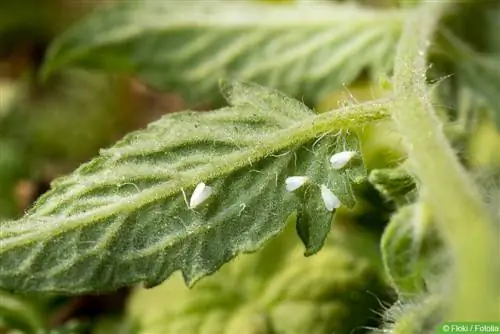
The curd soap solution is a good alternative to soft soap if this is not available. Depending on the soap, a little more or less than 30 grams are dissolved in the water. The leaves of the plants are wiped from both sides with a cloth soaked in it. This is how you can effectively fight larvae. The adult animals will also avoid the leaves treated in this way.
Tip:
Only use organic soap to avoid unwanted chemical additives in the solution.
Earth Exchange
As a supplementary measure after other control methods, replacing the soil can help prevent re-infestation. The soil contains eggs, larvae and adults that have escaped spraying and other pesticides.
- Repotting potted plants in new substrate
- replace the top layer in the bed (approx. 10-15 cm)
- Dispose of soil

